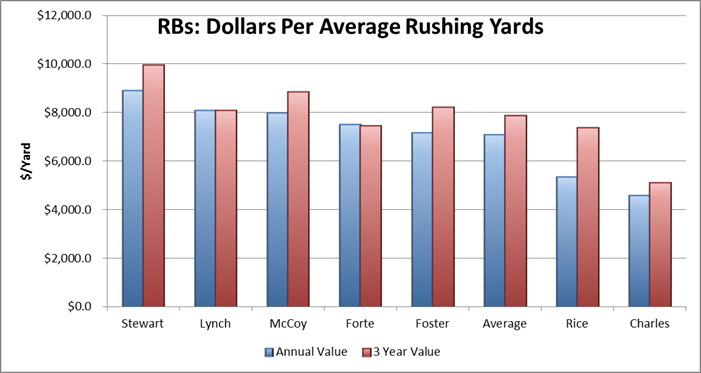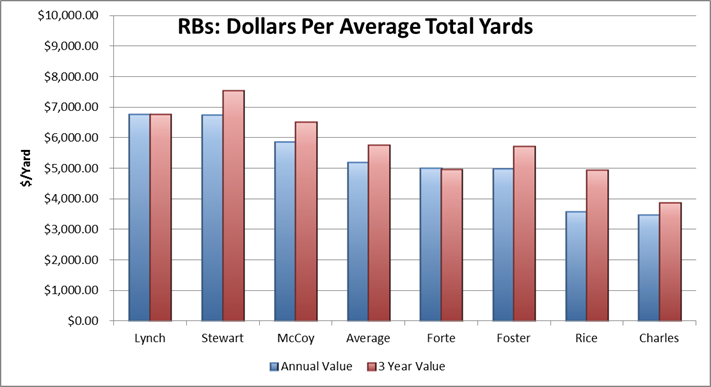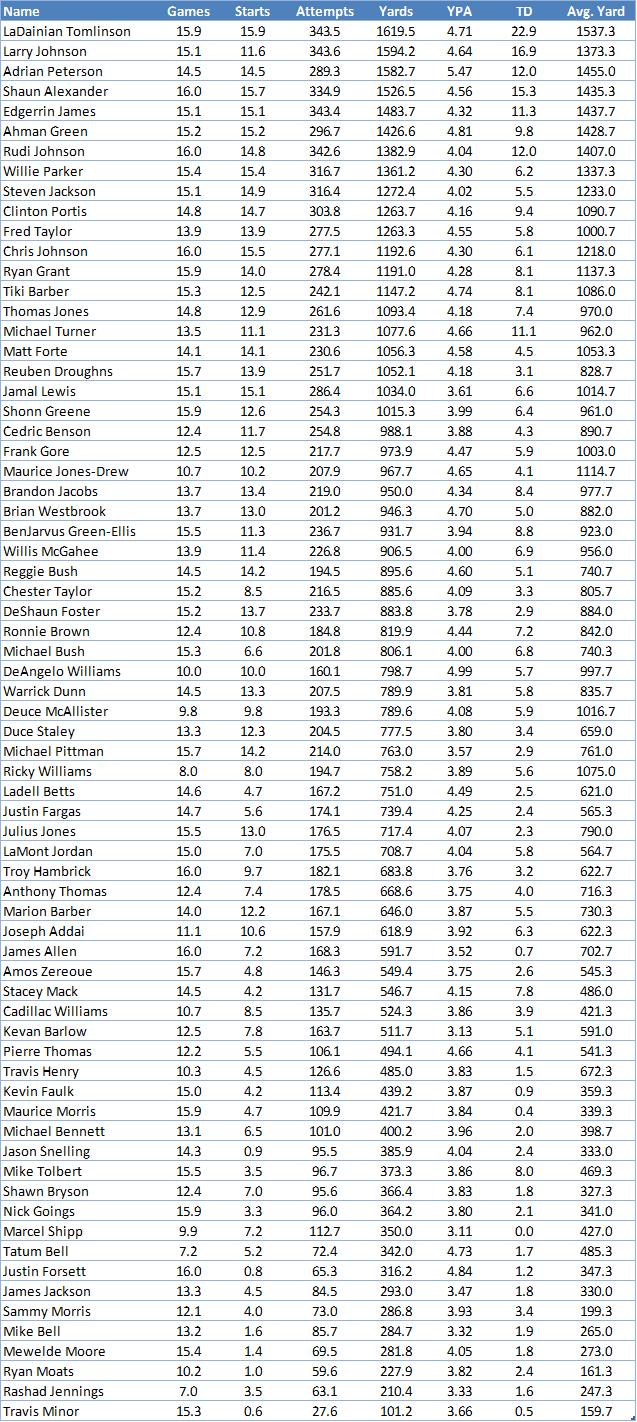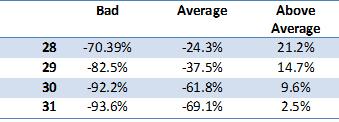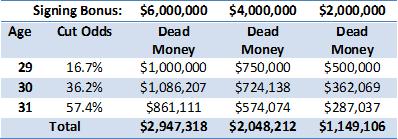[adsenseyu1]
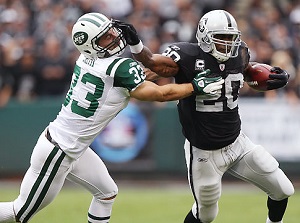
Chris Wesseling of NFL.com has posted yesterday that RB Darren McFadden of the Raiders was ready to play the season out in hopes of getting a lucrative contract in free agency next season. So with that in mind I figured we could take a look at the running back and see if he really has any hope of earning big dollars.
The running back market in general has come crashing down since the heyday of the Shaun Alexander and Ricky Williams. Between teams having their salary caps damaged by unproductive runners being paid millions of dollars and the explosion of the passing offense and influx of younger talented QB’s the running back became devalued tremendously.
The only two runners to “break the market” were Adrian Peterson and Chris Johnson, and those are both unrealistic data points for any player in the NFL. The true top of the market is between $7 and $9 million a year so I have to guess that is what McFadden is aiming for. The question is can he actually get there?
McFadden has a lot to overcome to even be considered in that grouping. The first issue is the injury history. No season, no matter how great, is going to convince a team that he can stay healthy and productive for 16 games. No team is going to spend big dollars on a player that is only healthy for 12 games and productive for 8 or 9. It ruins the flow of the offense.
Secondly he has to convince teams that the poor seasons were a fluke. McFadden has had more mediocre seasons than good seasons. He only ran for 500 yards as a rookie and 360 yards in his second season. He played very well in 2010 and started out well in 2011 before falling off a cliff in 2012, which he blamed on the blocking scheme. The fact that he is saying he can’t run behind a certain scheme could be troubling to a team.
The Upper Market Statistics
I first wanted to look at the top end of the market and use the two year averages leading up to an extension to come up with some basic goals for McFadden. (Please note that I am not including Jonathan Stewart of the Panthers simply because no team is going to use him as any point of comparison).
| Name | G | Run Yds | YPA | Rec Yds | TD | Touch | YPT | Big Play |
| McCoy | 15 | 1195 | 4.98 | 453.5 | 14.5 | 303 | 5.44 | 14.5 |
| Foster | 14.5 | 1420 | 4.69 | 610.5 | 15 | 362 | 5.61 | 17 |
| Rice | 16 | 1292 | 4.32 | 630 | 10.5 | 368.5 | 5.22 | 12 |
| Lynch | 15.5 | 971 | 3.99 | 175 | 9.5 | 268 | 4.27 | 7.5 |
| Forte | 14 | 1033 | 4.70 | 518.5 | 6.5 | 271.5 | 5.71 | 16.5 |
| Average | 15 | 1182 | 4.53 | 477.5 | 11.2 | 314.6 | 5.25 | 13.5 |
Making a Case For the High End
Because McFadden has basically no useful stats the last two seasons we have to assume teams will use that 2010 season as a point of reference along with 2013. In 2010 he rushed for 1157 yards on 223 carries and added 507 receiving yards on 47 receptions. While I don’t see teams agreeing to just blindly use that year as likely that is the best case he can make for himself. To get to the group averages McFadden is going to need the following stat line in 2013:
Games: 16
Carries: 300
Yards: 1207
Receptions: 60
Yards Rec: 448
TD: 13
Big Plays: 9
These numbers would all represent major career highs in touches as well as games played. Are those attainable? Probably not and he may need to exceed the numbers simply because we are using 2010 as a data point, which is an eternity ago in football years. While some people might point to the fact that 300 carries for 1200 yards is not as productive as he has been at his peak and that he can get 1200 yards with just 250 carries it’s not really the yards that are important. It’s the touches. It is the ability to carry the ball multiple times that brings financial value to a team.
The problem with an ultra productive player that only carries the ball 200 times is that the team then needs to sign someone to handle the missing 100 carries. That costs money and cap space. It’s like being injured and needing a decent replacement. A team doesn’t want to design an offense where Player A can do X, Y, and Z for 5.5 YPC and then supplant him for significant carries with Player B that can only do it for 2.5.
Essentially if McFadden can only carry for 220 times a year and you sign him for $8 million a year it means you need to sign or draft another productive player that can carry the ball 170 to 200 times. That brings your cost allocation from $7 or $8 million a year into the $10-$11 million a year range, a very high amount to spend on a running back.
The best case McFadden can make is to use Marshawn Lynch as a comparison point. When you look at the chart above Lynch is the one player who does not belong. His overall productivity was weak compared to others. He didn’t have the touches, didn’t factor into the passing game, and produced less than 4 yards a carry. Lynch had a few bad seasons leading into his extension. He was suspended for three games in 2009 and fell out of favor in Buffalo, only gaining 450 yards on the ground. He was traded the next year and produced an underwhelming 3.5 YPA for the Seahawks in 12 games. He also battled an ankle problem that year which he played through.
Those two seasons are not terribly different than what McFadden has done the prior two years. Lynch bounced back in 2011 to have a Pro Bowl season for the Seahawks and gaining 1200 rushing yards. Seattle took into account the distant past play when Lynch was a workhorse back with the Bills rather than considering 2011 the outlier and using his prior two years as reference points. Lynch would go on to have a monster season in 2012 justifying the overspending on the player.
The Secondary Market Statistics
While McFadden envisions himself in that group that earns $7 to $9 million a year, the more likely place for him is in the non-workhorse section of the market which varies from $3 million to $6.4 million a year. These are the players who teams do not have faith in being able to carry a full load or being able to remain healthy for 16 games. They understand the risks associated with the talent and are only going to spend a limited amount of cap dollars. Using the same two year averages here is that group of players:
| Name | G | Run Yds | YPA | Rec Yds | TD | Touch | YPT | Big Play |
| R. Bush | 15.5 | 1036 | 4.68 | 294.0 | 7.5 | 260.5 | 5.1 | 8.5 |
| Charles | 15.5 | 1293.5 | 6.16 | 382.5 | 8.0 | 252.5 | 6.6 | 14.5 |
| BGE | 16 | 837.5 | 4.09 | 122.0 | 12.0 | 215.5 | 4.5 | 3.5 |
| M.Bush | 15 | 816 | 3.94 | 306.0 | 8.0 | 234.5 | 4.8 | 8.0 |
| Gore | 12.5 | 986.5 | 4.57 | 429.0 | 9.0 | 265.0 | 5.3 | 13.0 |
| Average | 15 | 995.8 | 4.72 | 276.1 | 8.9 | 240.8 | 5.3 | 9.5 |
Making a Case For the Secondary Tier
Using this subset McFadden doesn’t need to push for a team to use 2010 as a baseline. All he needs to do is come close to recreating 2010 and he will easily surpass the averages of this group with the exception of games played. If he put up his 2010 numbers over a 16 game stretch he’d be more proficient than everyone except Charles. Being that McFadden has top draft talent, is far superior as a big play threat, and could convince teams to throw out that 2012 season he can easily push to the top of this list.
There are a number of easy comparisons here. The most logical would be Bush. Bush was a former number 2 overall pick who did very little in New Orleans over the first five seasons of his career. He received more opportunity with the Dolphins and turned himself into a viable mid tier back capable of carrying 200 times a year. Bush is 28 in his season of signing with Detroit. McFadden will be 27 if he plays the season out. Bush received $4 million a season from Detroit with $5 million in full guarantees.
Another point of reference would be Frank Gore. Gore had a more productive career than McFadden but looked as if all the wear and tear of his early years had worn him down. He was 28 when he signed a 3 year extension that did not begin until he was 29 years old. Gore received a close to high end value with significant money tied up in per game roster bonuses because of fear of injury.
Setting a Price
The following chart illustrates the contract values and full guarantees of the various players we discussed above plotted simply against average combined yards over the two years before the new contract.
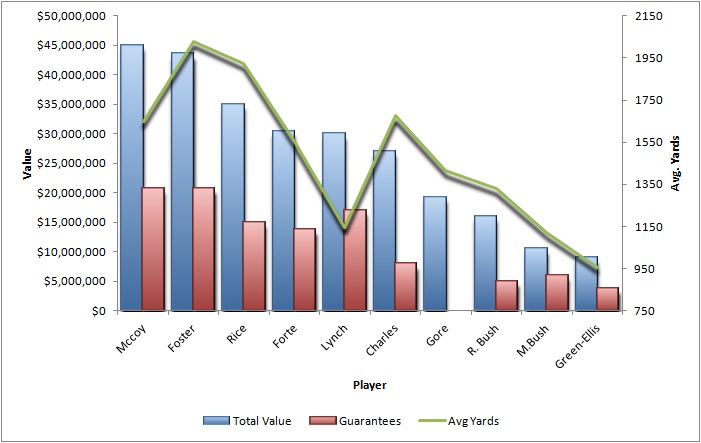
I would consider Lynch’s contract, worth $7.5 million a year, to be the highest possibility for McFadden and that is probably a stretch price. Seattle has not been the most cautious team in the league in regards to contract decisions leaning much more towards payment based on upper level potential rather than proven results. Given the Raiders cap history and knowing that their General Manager, Reggie McKenzie, comes from a system that takes the pessimistic approach to payment on potential it would be highly unlikely that the Raiders would ever consider matching a 4 year $30 million dollar contract with $17 million fully guaranteed for a player with McFadden’s history. That doesn’t mean somebody won’t do it but I can’t imagine that team being the Raiders barring a historic season by McFadden.
A more realistic number is between that $4 million and $6.4 million range of the second tier of players with minimal guarantees and for shorter terms in length. Though Charles was much younger when he signed his contract I could see the $5.4 million being a fair figure for McFadden if he has a good season. If he is willing to hedge his bets on his skill guarantees I think they could push the value closer to Gore’s.
Gore received more money potential for giving up true guarantees. This is not completely uncommon in the NFL. Darrelle Revis, CB for the Buccaneers, did the same in order to receive a contract far exceeding his “on paper” value, especially in light of an ACL injury that sidelined him for almost all of 2012. Gore’s lack of skill guarantees combined with heavy incentives based on staying healthy would seem like an ideal model for McFadden.
This style of contract fits in with McKenzie’s background with the Green Bay Packers and what he has started to use in Green Bay. McKenzie has also shown a willingness to use incentives in his contracts to push the value beyond the stated values in the contract which could also be used to max McFadden out if he was to produce the way Lynch ended up producing this past season. Again the incentives are not terribly uncommon as Rice’s contract contains performance incentives that would push his value closer to his “on paper” production level if he continued to hit certain statistical thresholds. Gore’s contract also contains added performance incentives.
The Risks of Playing the Season Out
Contrary to popular opinion I don’t think McFadden has any leverage right now despite his team high $9.68 million dollar cap number. None of McFadden’s salary is guaranteed and the Raiders are no longer hurting for cap dollars. Next season the Raiders will be flush with cap space as they try to build their roster essentially from scratch and a few extra carryover dollars from McFadden reworking his contract means nothing.
I am not sure what the Raiders would consider fair value for him now, but I wouldn’t imagine it would be much more than what the Dolphins paid Bush in 2010. Bush received a contract worth $4.875 million per year over two years with just $2.5 million in guarantees. The contract was completely based on potential and the belief that he would be a better fit in the Dolphins offense than the Saints offense. That money would be in addition to his $5.85 million dollar salary he is earning now.
If McFadden is unsuccessful this year in improving on 2012 he probably will not even receive that much money in free agency. I think because of the failures of McCoy, Foster, Forte, Stewart, DeAngelo Williams, etc… teams are more hesitant than ever to invest. In terms of annual value Bush, despite being more productive, is earning less than he did off his nothing seasons with New Orleans. Our own valuation of McFadden based on last season said he was worth only $1.9 million a season.
If McFadden were to hit free agency he could find his options limited. His statements about the offensive scheme could eliminate teams from considering him and he will likely only be picked up by a team needing a complementary piece. Most likely he would need to take an Ahmad Bradshaw style 1 year $2 million dollar contract with next to nothing guaranteed as a way to prove himself and Bradshaw was far more productive than McFadden.
So if the Raiders were offering him such a deal he could lock himself into a good chance to earn close to $10 million in 2014 and 2014 with the Raiders. With so many holes to fill as long as McFadden has a pulse they may be willing to stick with him especially since he will not damage their salary cap at those figures. So you could be looking at an $8 million dollar loss by hoping for a higher value contract. McFadden also has to consider the franchise tag as a realistic option even he plays well because the Raiders will be cap rich in 2014 and can easily take on a one year $8.5 million cap hit for a question mark player.
As a point of reference Bush’ s new contract will only pay him $8.5 million over the next two years and Gore’s paid $11.1 million in his first two extension years. If the Raiders were willing to go to $9 million or so in a two year extension (and we have no idea if they would be willing to do so) he would really be giving up very little value over his likely market price even if he had a pretty productive year as his base values of his contract may very likely end up right at the same figure. Really what he would be giving up would be some added backend contract value that is always non guaranteed and the incentives that could be part of an extension.
For this to truly be worth the risk, McFadden is going to have to put up absolutely incredible numbers, not have the franchise tag applied, and find a team willing to spend for an outside player based on a one year data point. None of the big contracts were free agent acquisitions as all players re-signed with their own teams, so free agency for runners is generally soft. That is a lot of things that need to occur for a player who typically plays 12 or 13 games a season to get the kind of money he hopes to get by playing the season out.
[subscribe2]
[adsenseyu2]
